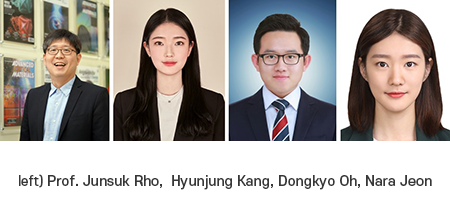Reviewed by Lexie CornerMay 10 2024
A recent study by researchers at Pohang University of Science and Technology represents a significant stride in advancing novel nanocomposites and defining an optimal criterion for crafting metaholograms tailored to the ultraviolet spectrum rather than the visible. They aimed to pinpoint the ideal printing material for creating UV metasurfaces. The findings of this study were published in the journal Microsystems & Nanoengineering.
 [Professor Junsuk Rho’s team at POSTECH delves into the composition of nanocomposites for ultraviolet metasurface fabrication]. Image Credit: Pohang University of Science and Technology.
[Professor Junsuk Rho’s team at POSTECH delves into the composition of nanocomposites for ultraviolet metasurface fabrication]. Image Credit: Pohang University of Science and Technology.
Professor Junsuk Rho of the Mechanical, Chemical, and Electrical Engineering Departments at Pohang University of Science and Technology (POSTECH), Ph.D. candidates Hyunjung Kang and Nara Jeon from the Mechanical Department, and Ph.D. student Dongkyo Oh from the Mechanical Department successfully carried out a thorough quantitative analysis.
These incredibly thin optical devices are called metasurfaces, and they excel at controlling light down to a thickness of just one nanometer. There has been ongoing research on metasurfaces as a key technology for the development of next-generation displays, imaging, and biosensing. They penetrate the domains of infrared and ultraviolet light in addition to visible light.
A metasurface production technique called nanoimprint lithography works similarly to a stamp that can make multiple copies from a single mold. This novel method enables the commercial viability of metasurfaces by enabling their large-scale and reasonably priced production.
Unfortunately, the low refractive index of the resin used as the printing material is a drawback that makes effective light manipulation difficult. To solve this problem, researchers are actively investigating nanocomposites, which incorporate nanoparticles into resin to increase its refractive index. However, this method's effectiveness relies on several variables, including the type of nanoparticle and the solvent selected, so a methodical analysis is required to achieve the best metasurface performance.
The group painstakingly planned experiments to assess how solvent choice and nanoparticle concentration affected UV metaholograms and pattern transfer. They specifically adjusted the concentration of zirconium dioxide (ZrO2), a nanocomposite well-known for producing UV metaholograms, from 20 % to 90 %. The results demonstrated that an 80 % concentration level was necessary for maximum pattern transfer efficiency.
By incorporating ZrO2 at an 80 % concentration with different solvents such as methylisobutyl ketone, methyl ethyl ketone, and acetone for metahologram fabrication, the conversion efficiency surged in the ultraviolet spectrum (325 nm), achieving remarkable levels of 62.3 %, 51.4 %, and 61.5 %, respectively.
This study represents a noteworthy advancement by defining an optimal criterion for creating metaholograms tailored specifically for the ultraviolet realm, distinct from the visible range. It also spearheads the exploration of novel nanocomposites.
The use of titanium dioxide (TiO2) and silicon (Si) nanocomposites instead of ZrO2 expands the applicability to visible and infrared light. Our future research endeavors will focus on refining the preparation conditions for optimal nanocomposites, thus propelling the advancement, application, and expansion of optical metasurface fabrication technology.
Junsuk Rho, Professor, Pohang University of Science and Technology
The study was funded by the N.EX.T IMPACT of POSCO Holdings, the Alchemist Project of the Ministry of Trade, Industry, and Energy and the Korea Planning & Evaluation Institute of Industrial Technology, the STEAM Research Program, the RLRC Program, and the Nano-materials Source Technology Development Project of the National Research Foundation of Korea and the Ministry of Science and ICT.
Journal Reference:
Kang, H., et al. (2024) Tailoring high-refractive-index nanocomposites for manufacturing of ultraviolet metasurfaces. Microsystems & Nanoengineering. doi.org/10.1038/s41378-024-00681-w.